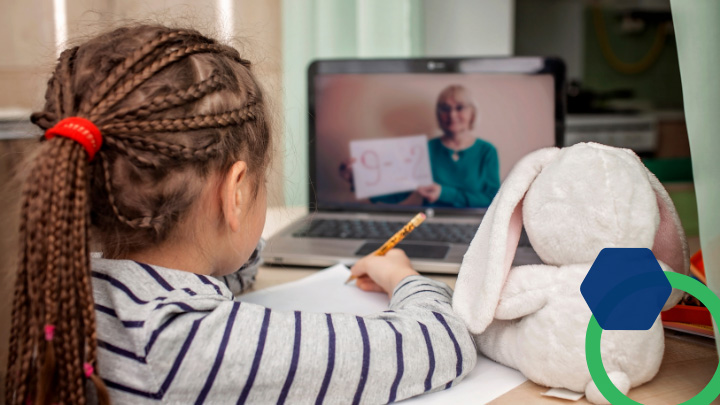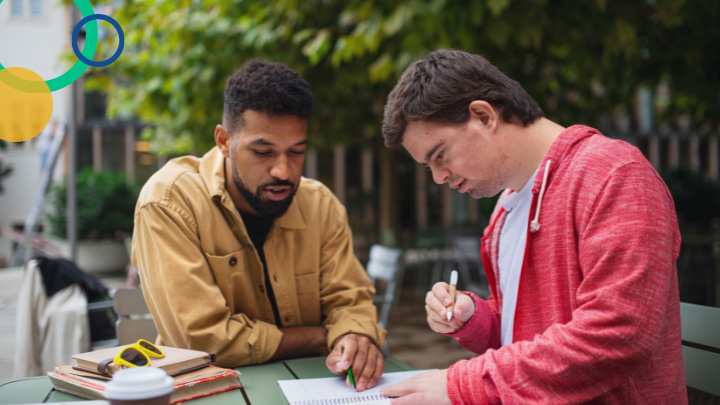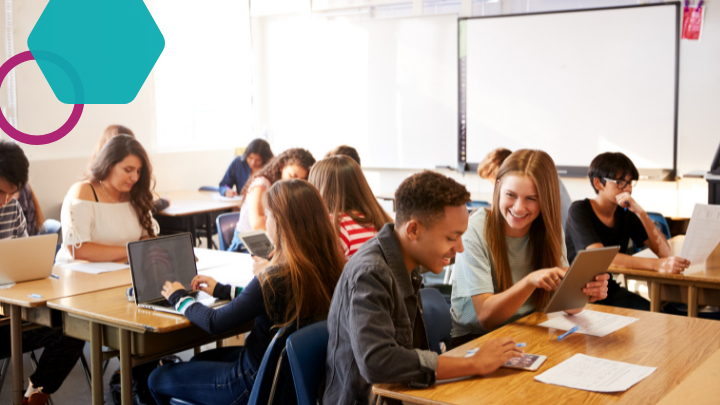Mayra is a K-2 special education teacher, who works with 12 students at multiple grade levels in a self-contained classroom. Her school serves about 700 students and is located in a small, racially and socioeconomically diverse city in the Northeast. I’ve been Mayra’s BetterLesson instructional coach since October 2019. When we first began to work together, we focused on supporting one of her new students who faced severe emotional challenges and on collecting informal academic data to help group students and differentiate instruction. Both of these foci were in support of Mayra’s vision: building lifelong learners who could work together as a community of problem-solvers.
When COVID-19 disrupted the year, Mayra and I (like every other educator) were thrown into a brand new world. By working together to identify challenges and try new strategies, we endeavored to build towards her vision in the midst of unprecedented circumstances.
“Where do I start?”
In our first call after shifting school online, Mayra’s most pressing concern was that students might lose momentum because they would no longer have the in-person support they were accustomed to. Mayra wondered how to provide students with a rigorous and exciting learning experience online.
I posed the following questions to guide her thinking about her distance learning plan:
- How will you communicate with students and parents?
- What work will students be expected to complete? How will you assign and collect that work?
- What weekly routines should we put in place to help students and families plan for the week and anticipate assignments and communication?
Mayra prioritized tools and activities that parents were familiar with or that would be easy for them to learn. For that reason, she chose ClassDojo as the communication tool through which she answered questions, sent updates and reminders, and distributed weekly work. She also decided to offer a Zoom class opportunity for students so that they could continue their social development and work with her to address their academic needs.
To provide flexibility to parents and students, Mayra decided to use choice boards to assign work. Each choice board contained multiple activities that worked towards the same standards or group of standards so that parents and students could select assignments based on their interests and time constraints, while all working toward the same goals. To ensure that her schedule and expectations were easy to follow, Mayra set up the following weekly calendar:
Monday: Choice Board assigned
Tuesday: Zoom class
Wednesday:
Thursday:
Friday: Choice board due
“Zoom class isn’t working – what’s the solution?”
Parents continued to communicate with Mayra in ClassDojo, and students had moderate success with choice boards. However, the first Zoom class meetings felt hectic and were poorly attended.
I posed the following questions to bring us to a sustainable solution:
- What felt hectic about the meetings? Why were students disinvested in attending?
- What would you do about this in the classroom?
- What solutions would be possible in the distance learning context?
Mayra named that students were used to getting more individual or small-group attention and that it was hard to deliver that within a Zoom meeting with other students talking and with many distractions visible in the background. The first adjustment we made was to split the class into two groups so that it was easier to speak to each student individually and to give the class targeted small-group support. She also started offering an additional optional Zoom meeting for students who were feeling disconnected and wanted more social time with her and each other. She added those to her weekly calendar and committed to keeping the times for each meeting consistent to add to the predictability of the scheduling.
Monday: Choice Board assigned
Tuesday: Zoom Group 1 and Zoom Group 2
Wednesday:
Thursday: Optional whole group Zoom
Friday: Choice board due
The change led more students to attend the meetings, and the meetings felt more productive.
“How can we support the parents?”
After experiencing the first two weeks of distance learning, Mayra observed a great need for increased parental involvement because of flagging student completion of choice boards. In the school building, students were accustomed to individual support, small group instruction, and the myriad social interactions they had daily with the adults and students in Mayra’s classroom. But during the pandemic, parents were juggling both their own work and their children’s education, so it was difficult for them to provide all of the support and structure students were accustomed to in the classroom.
I posed the following questions to help Mayra develop a clear plan for parent support:
- What do parents need to know/be able to do in order to support their children?
- What kind of support would be accessible to most parents while also being sustainable?
Mayra came to the conclusion that in order for parents to be prepared to take on this role of surrogate teacher while juggling so many others, she would have to provide direct support to families. Mayra started optional “parent office hours,” a weekly phone call parents could join without their students. Mayra encouraged parents to bring their questions and concerns to the meeting. She started each meeting by going through the information sent home by the school to ensure that parents understood all communication. Then she explained her choice boards for the week, and, finally, she opened up the floor for parent questions and comments. Her weekly routine was updated:
Monday: Choice Board assigned
Tuesday: Zoom Group 1 and Zoom Group 2
Wednesday: Parent office hours
Thursday: Optional whole group Zoom
Friday: Choice board due
These meetings caused a dramatic shift in the engagement of students. Parents expressed feeling more comfortable supporting their students because they understood expectations. Mayra also got feedback from parents around which assignments were interesting, boring, easy to use, more complex, etc., which helped her design the following weeks’ materials. She noted a dramatic increase in the number of choice boards turned in.
“How can we help learning feel ‘normal’ in this new context?”
Mayra was in a rhythm with students and parents and had considerable engagement both in her Zoom classes and with the choice boards she assigned. With the weekly routine in place, it was time to think back to the goals and priorities we set forth at the beginning of our work together.
I posed the following questions to help us build on the success Mayra was experiencing:
- What was your initial vision?
- Are we making progress towards that vision?
- What can we do within your current distance learning plan that will help us build on that important work?
Through this exercise, she realized that she wasn’t providing comparable activities to what she had been able to facilitate in the classroom. Students were still working towards the same objectives, but the activities either reviewed something she had previously taught, or they relied on parents to teach students. She had not yet developed or assigned activities that were exploratory or experience-based. These were the types of lessons in class that would get students working together and excited to learn.
We thought about what types of projects would be easy, interesting, and inexpensive and that could address the math content standards she was responsible for: measurement and time. Because of their wide appeal, she decided to use boxed brownies. Mayra advertised that she would use her optional whole-class Zoom time to teach a fun lesson using brownies and let parents know in advance to buy the ingredients if they would like to.
Kids were able to learn by interacting with their physical environment and excitedly answered Mayra’s questions. It felt like being in the classroom again because students were united around a learning project that connected to their lives.
“I’m going to take this into fall.”
In our last meeting, I used a simple reflection protocol with Mayra. I asked her to think about planning for the upcoming school year by evaluating the practices she had used both in-person and throughout distance learning and responding to the following questions:
- What would you keep doing?
- What would you start doing?
- What would you stop or change?
We realized that the schedules, tools, and lessons we came up with during distance learning have much broader applicability to her role because they can be implemented in either context. Whether she is back in school in-person or online, Mayra will plan to continue holding parent office hours because she saw that they gave families an easy way to communicate questions and concerns, which caused an increase in parent involvement and student investment. The clear, consistent weekly schedule allowed students to more quickly acclimatize to distance learning by giving them predictability. Mayra will continue this format when facilitating distance learning in the upcoming year. Mayra is planning to bring choice boards into the classroom as well to help her personalize the learning pathways for students.
Mayra’s commitment to experimenting with new strategies and tools and adjusting course when necessary allowed her to discover effective distance learning practices which will be useful to her when she returns to work with students in the physical classroom as well.
BetterLesson supports teachers, instructional coaches, and administrators as they face the challenge of creating flexible, equitable, student-centered learning environments – whether learning happens in-school, online, or in a hybrid model.
Get Started






